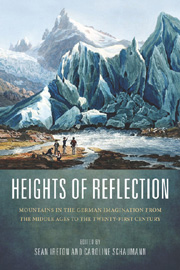 Heights of Reflection
Heights of Reflection from Part III - Modern Expeditions and Evocations: Climbing from the Twentieth into the Twenty-First Century
Published online by Cambridge University Press: 05 February 2013
Es ist offenbar viel schwieriger, den Berg auf die Leinwand als den Menschen auf den Berg zu bringen.
—Reinhold Messner, 13 Spiegel meiner Seele[It is apparently much more difficult to bring a mountain to the movie screen than to put a person on the mountain.]
In 1984 Herzog accompanied the famous South Tyrolean mountain climber Reinhold Messner on an expedition to the central Karakoram mountain range in northeastern Pakistan to film the latter's attempt at an unprecedented climbing feat. Messner and his fellow climber Hans Kammerlander were seeking to become the first to ascend two 8,000-meter peaks (Gasherbrum I and Gasherbrum II) in succession without returning to base camp. In a voiceover during an extended panning shot of the Karakoram at the beginning of the film, Herzog lays out what he wanted to explore in the resulting television documentary, Gasherbrum — Der leuchtende Berg (Gasherbrum — the glowing mountain, 1985):
Uns interessierte nicht so sehr einen Film über die bergsteigerische Tat oder über Klettertechnik zu machen. Was wir wissen wollten, war: was geht in Bergsteigern vor, die so etwas Extremes unternehmen?
[We weren't so much interested in making a film about mountain climbing per se, or about climbing techniques. What we wanted to find out was what goes on inside mountain climbers who undertake such extreme endeavors.]
To save this book to your Kindle, first ensure [email protected] is added to your Approved Personal Document E-mail List under your Personal Document Settings on the Manage Your Content and Devices page of your Amazon account. Then enter the ‘name’ part of your Kindle email address below. Find out more about saving to your Kindle.
Note you can select to save to either the @free.kindle.com or @kindle.com variations. ‘@free.kindle.com’ emails are free but can only be saved to your device when it is connected to wi-fi. ‘@kindle.com’ emails can be delivered even when you are not connected to wi-fi, but note that service fees apply.
Find out more about the Kindle Personal Document Service.
To save content items to your account, please confirm that you agree to abide by our usage policies. If this is the first time you use this feature, you will be asked to authorise Cambridge Core to connect with your account. Find out more about saving content to Dropbox.
To save content items to your account, please confirm that you agree to abide by our usage policies. If this is the first time you use this feature, you will be asked to authorise Cambridge Core to connect with your account. Find out more about saving content to Google Drive.